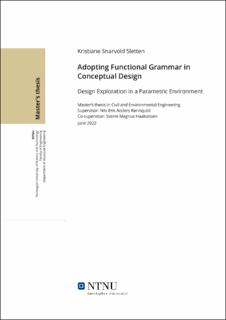| dc.contributor.advisor | Rønnquist, Nils Erik Anders | |
| dc.contributor.advisor | Haakonsen, Sverre Magnus | |
| dc.contributor.author | Sletten, Kristiane Snarvold | |
| dc.date.accessioned | 2022-09-28T17:42:11Z | |
| dc.date.available | 2022-09-28T17:42:11Z | |
| dc.date.issued | 2022 | |
| dc.identifier | no.ntnu:inspera:107175085:22693864 | |
| dc.identifier.uri | https://hdl.handle.net/11250/3022375 | |
| dc.description.abstract | Nye og avanserte digitale verktøy, som for eksempel programvarer innenfor parametrisk design, har hatt en positiv effekt på samarbeidet mellom arkitekter og ingeniører. Selv om de eksisterende beregningsverktøyene forbedrer samspillet, mangler de funksjoner for å utnytte det fulle potensialet ved et samarbeid i den konseptuelle fasen. Det betyr at arkitekter med sine modelleringsverktøy designer geometrien uten å ta hensyn til konstruksjonens bærevne, mens ingeniørenes analyseverktøy har behov for en forhåndsdefinert geometri for å utføre beregningene. Funksjonell grammatikk, introdusert av William J. Mitchell, har som mål å integrere metodene ved å kombinere designutforskning og konstruksjonsanalyse.
Denne masteroppgaven fordyper seg i funksjonell grammatikk som baserer seg på formgrammatikk, det vil si at design blir generert basert på regler som endrer på den initielle formen. Den digitale implementering av funksjonell grammatikk for å oppnå en generativ designutforskning parallelt med konstruksjonsanalyse innebærer å utvikle en programvareutividelse i Grasshopper som inneholder et sett av regler for å endre på geometrien. I tillegg til å integrere programvare for analyse, kan ytterligere aspekter legges til for å utnytte potensialet ved metoden. For eksempel, tar denne oppgaven for seg prisestimering og en prediksjon av CO2-ekvivalenter som medfører flere dimensjoner å vurdere konstruksjonsystemer ut i fra.
Etter å ha etablert algoritmen, ble det en rekke designalternativer manuelt utarbeidet for å demonstrere potensialet til funksjonell grammatikk ved designutforsking. Studiet oppdaget at det varierte hvilke konfigurasjoner som var den mest gunstige basert på hvilket aspekt som ble validert høyest. I tillegg illustrerte den hvor effektiv og lettvint bruken av metoden er når den allerede har blitt etablert. Den multi-objektive optimaliseringen ble utført med mål om å minimere forskyvning, prisestimering og CO2-ekvivalenter med utnyttelse og knekklastfaktor som begrensninger. Det viste seg at optimaliseringen genererte mindre verdifulle arkitektoniske uttrykk enn de designalternativer som var valgt manuelt. Det kreves korte og effektive koder for å oppnå raske og nøyaktige beregninger og gjennomførbare konstruksjoner. Dette studiet har demonstrert fleksibiliteten og nytten av formgrammatikk i tidlig designfase. | |
| dc.description.abstract | New and advanced digital tools, like parametric design software, have positively influenced the synergy between architects and engineers. Even though the existing computational tools enhance the collaboration, it lacks the features to take advantage of the cooperation's potential in the conceptual phase. Architectural modelling tools design geometry in the absence of structural performance, while engineers' structural analysis tools need a predefined geometry to be analysed. Functional grammar, introduced by William J. Mitchell, aims to integrate these methods by combining design exploration and structural analysis.
This thesis addresses this topic, and the approach is based on shape grammar. That is, shapes get modified and generated when rules are applied to an initial shape. The intention of the digital implementation of functional grammar is to achieve a generative design exploration parallel with analysing the structural performance. It involves developing rules as plug-in components for Grasshopper to perform these operations. In addition to integrating structural analysis software, other aspects can be combined with shape grammar to exploit the approach's power. For instance, this thesis adds price estimation and a prediction of CO2 equivalents to accomplish another dimension for evaluating structures.
After establishing the algorithm, a manual design exploration was executed to demonstrate the power of functional grammar as a design approach. The investigation discovered that different configurations were the most favourable based on which objective was validated the highest. Further, it illustrated the effectiveness and simplicity of the method when it already was constructed. A multi-objective optimisation aimed to minimise displacement, price estimation and CO2 equivalents with utilisation and buckling load factor as constraints. The optimisation generated less valuable architectural language than the manual design alternatives. It requires short and efficient scripts to achieve quick and accurate computations and feasible structures. The study has demonstrated the flexibility and usefulness of shape grammars in early-stage design. | |
| dc.language | eng | |
| dc.publisher | NTNU | |
| dc.title | Adopting Functional Granmmar in Conceeptual Design
Design Exploration in a Parametric Environment | |
| dc.type | Master thesis | |
